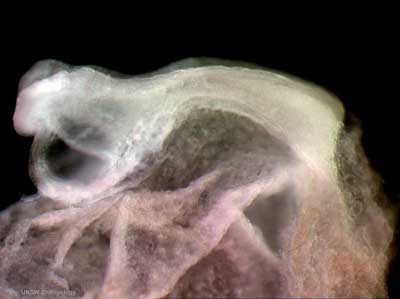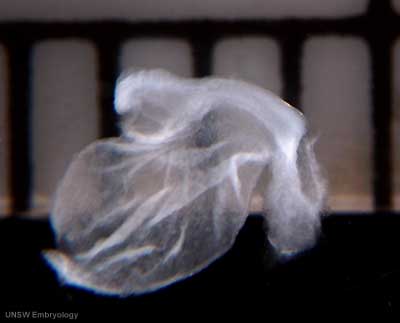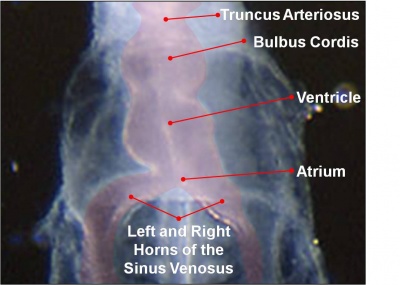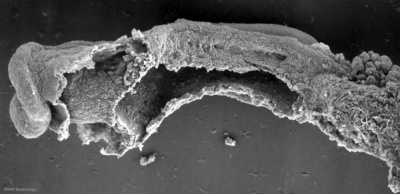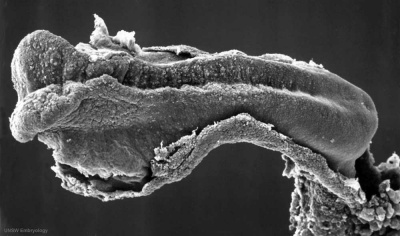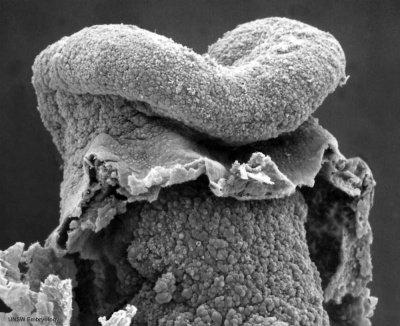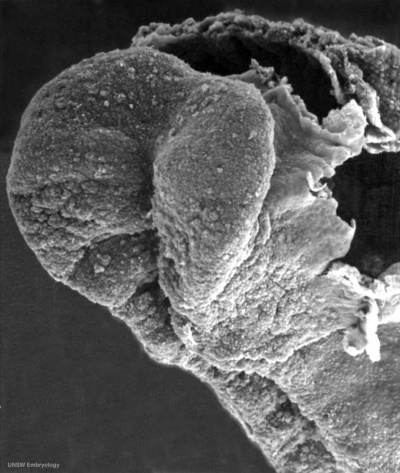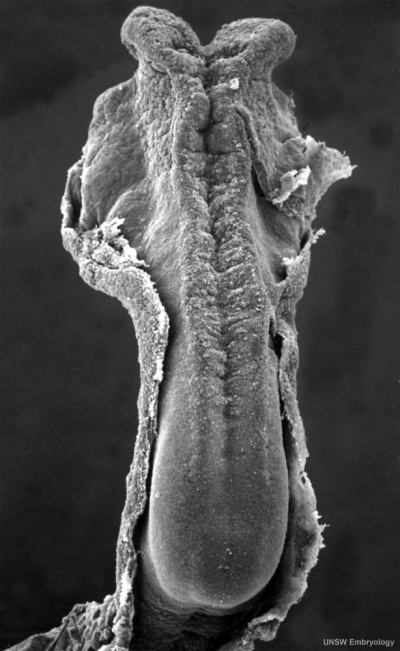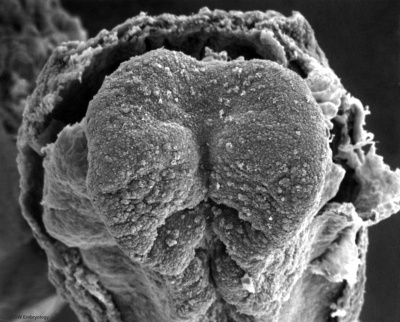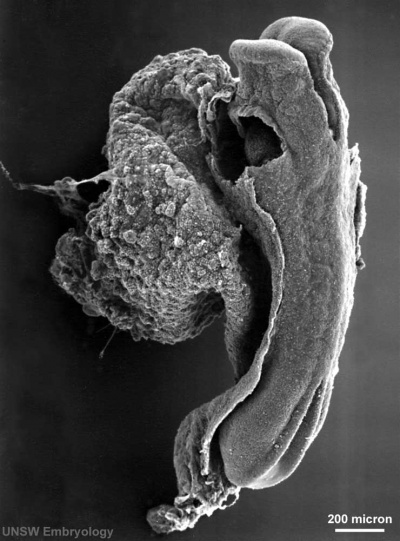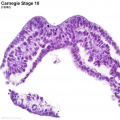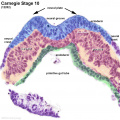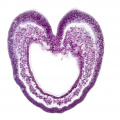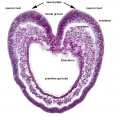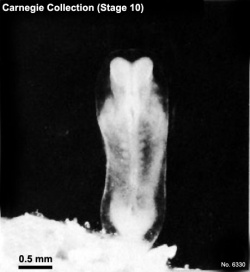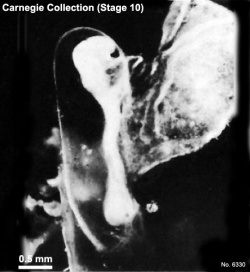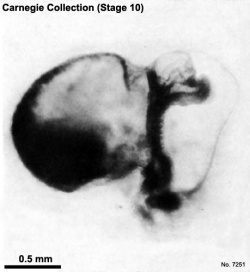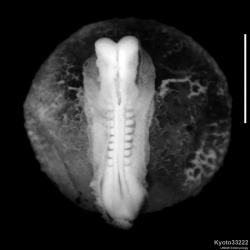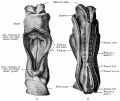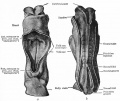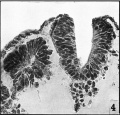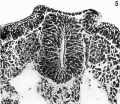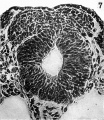Carnegie stage 10
| Embryology - 25 Apr 2024 |
|---|
| Google Translate - select your language from the list shown below (this will open a new external page) |
|
العربية | català | 中文 | 中國傳統的 | français | Deutsche | עִברִית | हिंदी | bahasa Indonesia | italiano | 日本語 | 한국어 | မြန်မာ | Pilipino | Polskie | português | ਪੰਜਾਬੀ ਦੇ | Română | русский | Español | Swahili | Svensk | ไทย | Türkçe | اردو | ייִדיש | Tiếng Việt These external translations are automated and may not be accurate. (More? About Translations) |
Introduction
Facts
Week 4, 22 - 23 days, 2 - 3.5 mm, Somite number 4 - 12
Gestational Age GA - week 6
Features
- Somite Number 4 - 12, rostral neuropore, neural folds in region of developing brain, neural tube, somites, caudal neuropore, neural fold fuses, remnant of amniotic sac
Summary
- Ectoderm: Neural fold deeepens, edges approach midline, neural fold fuses, neural plate folds ventrally in brain region
- Mesoderm: Somitogenesis, continued segmentation of paraxial mesoderm (4 - 12 somite pairs)
See also Events
Identify
The rostral neuropore, neural folds in region of developing brain, neural tube, somites (note the different number formed), caudal neuropore, neural fold fuses, cut edge of amniotic sac.
- Links: Week 4 | Gastrulation | Lecture | Practical | Carnegie stage 10 image gallery | Category:Carnegie Stage 10 | Stage 11
| Week: | 1 | 2 | 3 | 4 | 5 | 6 | 7 | 8 |
| Carnegie stage: | 1 2 3 4 | 5 6 | 7 8 9 | 10 11 12 13 | 14 15 | 16 17 | 18 19 | 20 21 22 23 |
- Carnegie Stages: 1 | 2 | 3 | 4 | 5 | 6 | 7 | 8 | 9 | 10 | 11 | 12 | 13 | 14 | 15 | 16 | 17 | 18 | 19 | 20 | 21 | 22 | 23 | About Stages | Timeline
Bright Field
Scanning EM
Image Source: Scanning electron micrographs of the Carnegie stages of the early human embryos are reproduced with the permission of Prof Kathy Sulik, from embryos collected by Dr. Vekemans and Tania Attié-Bitach. Images are for educational purposes only and cannot be reproduced electronically or in writing without permission.
Kyoto Collection
Facts: Week 4, 22 - 23 days, 2 - 3.5 mm, Somite Number 4 - 12
View: This is a dorsal view of the human embryo, the amniotic membrane has been removed. Top embryo is an early stage 10, bottom is late stage 10.
| Early | Late | |
|---|---|---|
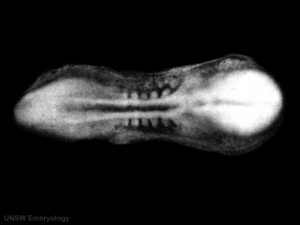
|
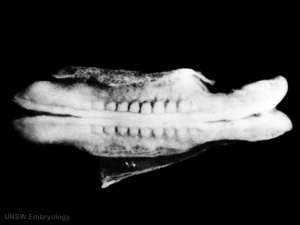
|
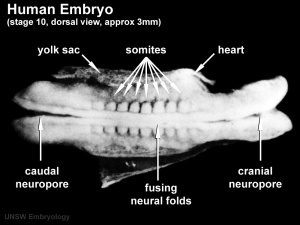
|
| Stage 10 Embryo (12202) - transverse section |
|---|
|
|
Image source: The Kyoto Collection images are reproduced with the permission of Prof. Kohei Shiota and Prof. Shigehito Yamada, Anatomy and Developmental Biology, Kyoto University Graduate School of Medicine, Kyoto, Japan for educational purposes only and cannot be reproduced electronically or in writing without permission.
Carnegie Collection
| Carnegie Collection - Stage 10 | ||||||||||
|---|---|---|---|---|---|---|---|---|---|---|
| Serial No. | Pairs of somites | Size (mm) | Grade | Fixative | Embedding Medium | Thinness (µm) | Stain | Year | Notes | |
| 391 | 8 | E, 2 Ch., 14 | Good | Formalin | P | 10 | Al. coch. | 1907 | Monograph by Dandy (1910)[1] | |
| 1201 | 7 | E,2 Ch.. 144 | Good | Formalin | P | 8 | H. & or. G. | 1915 | Univ. Chicago No. H 87 | |
| 2795 | 4-5 | E,2 | Poor | Alc. | P | 6 | Al coch,or.G. | 1919 | ||
| 3707 | 12 | E, 1 5 | Good | Formalin | P | 12.5 | I. H. | 1921 | Univ. Calif. No. H 197 | |
| 3709 | 4 | E. 1.4 Ch.. 14.8 | Poor | Formalin | P | 10 | Erythrosin | 1921 | Univ. Chicago No H 279 | |
| 3710 | 12 | E., 3.6 Ch., 19.0 | Good | Formalin | C-P | 10 | H. & or. G. | 1921 | Univ. Chicago No. H 392 | |
| 4216 | 8 | E, 2 Ch, 9.8 | Good | Formalin | P | 15 | ? | 1923 | Monograph by Payne (1925)[2] | |
| 5074 | 10 | E., 3.3 Ch., 10.8 | Exc. | Bouin | P | 10 | Al. coch. | 1925 | Univ. Rochester No. H 10. Monograph by Corner (1929)[3] | |
| 6330 | 7 | E, 2.83 | Good | P | 5 | Ehr. H. | 1931 | Univ. Chicago No. H 1404 | ||
| 6740 | 12 | E., 2.2 | Good | p | C-P | 8 | ? | 1933 | Litzenberg embryo. Studied by Boyden (1940) | |
| 7251 | 8 | E., 1.27 | Good | Formalin | C-P | 10 | (Stain - Haematoxylin Eosin) | 1941 | "Singapore embryo." Univ. Cambridge No. H 98. Studied by Wilson (1914)[4] | |
| 8244 | 6 | E., 1.55 Ch, 8,5 | Good | Alc. | C-P | 8 | (Stain - Haematoxylin Eosin) phlox. | 1944 | ||
| 9870 | 12 | Ch, ca. 8 | Good | Zenker | P | 5 | Various, chiefly carmine | 1952 | Univ. Chicago. No. H 637. Dicephaly | |
Abbreviations
| ||||||||||
| iBook - Carnegie Embryos | |
|---|---|
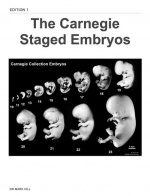
|
|
Events
For a detailed description of the stage 10 human embryos see the papers published 1910[1], 1929, [5], 1939 [6], review by Heuser in 1957[7] and in chapter by O'Rahilly and Müller in 1987.[8]
- Hearing - 10 somites first indication of otic placode invagination[5] 12 somites cells migrate from the otic disc.[9]
- Vision - optic primordia appear.[10]
References
- ↑ 1.0 1.1 Dandy WE. A human embryo with seven pairs of somites measuring about 2 mm in length. (1910) Amer. J Anat. 10: 85-109.
- ↑ Payne, F. 1925. General description of a 7-somite human embryo. Carnegie Instn. Wash. Publ. 361, Contrib. Embryol., 16,115-124.
- ↑ Corner GW. A well-preserved human embryo of 10 somites. (1929) Contrib. Embryol., Carnegie Inst. Wash. Publ. 394, 20:81-102.
- ↑ Wilson JT. Observations upon young human embryos. (1914) J Anat Physiol., 48(3): 315-51 PMID 17233002 PMC1288949
- ↑ 5.0 5.1 Corner GW. A well-preserved human embryo of 10 somites. (1929) Carnegie Instn. Wash. Publ. 394, Contrib. Embryol., Carnegie Inst. Wash. 20: 81-102.
- ↑ Baxter JS. and Boyd JD. Observations on the neural crest of a ten-somite human embryo. (1939) J Anat. 73: 318–326. PMID 17104759
- ↑ Heuser CH. and Corner GW. Developmental horizons in human embryos. Description of age group X, 4 to 12 somites. (1957) Carnegie Instn Wash Publ 611, Contrib. Embryol., 36: 29-39.
- ↑ O'Rahilly R. and Müller F. Developmental Stages in Human Embryos. Contrib. Embryol., Carnegie Inst. Wash. 637 (1987).
- ↑ Bartelmez GW. and Evans HM. Development of the human embryo during the period of somite formation, including embryos with 2 to 16 pairs of somites. (1926) Contrib. Embryol., Carnegie Inst. Wash. Publ. 362, 17: 1-67.
- ↑ <pubmed>7364662</pubmed>
Additional Images
Historic
Dandy WE. A human embryo with seven pairs of somites measuring about 2 mm in length. (1910) Amer. J Anat. 10: 85-109.
Baxter JS. and Boyd JD. Observations on the neural crest of a ten-somite human embryo. (1939) J Anat. 73: 318–326. PMID 17104759
Heuser CH. and Corner GW. Developmental horizons in human embryos. Description of age group X, 4 to 12 somites. (1957) Carnegie Instn Wash Publ 611, Contrib. Embryol., 36: 29-39.
- Carnegie Stages: 1 | 2 | 3 | 4 | 5 | 6 | 7 | 8 | 9 | 10 | 11 | 12 | 13 | 14 | 15 | 16 | 17 | 18 | 19 | 20 | 21 | 22 | 23 | About Stages | Timeline
Cite this page: Hill, M.A. (2024, April 25) Embryology Carnegie stage 10. Retrieved from https://embryology.med.unsw.edu.au/embryology/index.php/Carnegie_stage_10
- © Dr Mark Hill 2024, UNSW Embryology ISBN: 978 0 7334 2609 4 - UNSW CRICOS Provider Code No. 00098G
